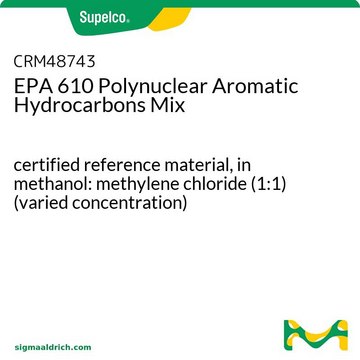CRM48905
Polynuclear Aromatic Hydrocarbons Mix
certified reference material, TraceCERT®, 2000 μg/mL each component in methylene chloride: benzene (1:1)
Synonym(s):
PNAs
Sign Into View Organizational & Contract Pricing
All Photos(1)
About This Item
UNSPSC Code:
41116107
NACRES:
NA.24
Recommended Products
grade
certified reference material
TraceCERT®
Quality Level
product line
TraceCERT®
CofA
current certificate can be downloaded
feature
standard type calibration
packaging
ampule of 1 mL
concentration
2000 μg/mL each component in methylene chloride: benzene (1:1)
technique(s)
HPLC: suitable
gas chromatography (GC): suitable
application(s)
environmental
format
multi-component solution
storage temp.
2-8°C
Looking for similar products? Visit Product Comparison Guide
Application
Refer to the product′s Certificate of Analysis for more information on a suitable instrument technique. Contact Technical Service for further support.
Other Notes
This Certified Reference Material (CRM) is produced and certified in accordance with ISO 17034 and ISO/IEC 17025. All information regarding the use of this CRM can be found on the certificate of analysis.
Legal Information
TraceCERT is a registered trademark of Merck KGaA, Darmstadt, Germany
Analyte
Description
Acenaphthene
Acenaphthylene
Anthracene
Benz[a]anthracene
Benzo[b]fluoranthene
Benzo[k]fluoranthene
Benzo[ghi]perylene
Benzo[a]pyrene
Chrysene
Dibenz[a,h]anthracene
Fluoranthene
Fluorene
Indeno[1,2,3-cd]pyrene
Naphthalene
Phenanthrene
Pyrene
See All (16)
Signal Word
Danger
Hazard Statements
Precautionary Statements
Flash Point(F)
12.0 °F
Flash Point(C)
-11.1 °C
Choose from one of the most recent versions:
Already Own This Product?
Find documentation for the products that you have recently purchased in the Document Library.
José Beirão et al.
Environmental pollution (Barking, Essex : 1987), 241, 521-528 (2018-06-09)
The effects of petroleum aromatic hydrocarbons (PAHs) on the embryonic and larval life stages of teleosts have been extensively examined. However, very little work has been conducted on how spilled oil affects fish sperm and there is no related knowledge
Abhrajyoti Tarafdar et al.
Environmental geochemistry and health, 42(6), 1691-1704 (2019-05-28)
Children can get affected by polycyclic aromatic hydrocarbons (PAHs) while they interact with play area soil/rubber surfacing and exposed to PAHs by dermal contact, inhalation and hand-to-mouth activity. A comparative study has been conducted on PAHs profiling and probable cancer
Our team of scientists has experience in all areas of research including Life Science, Material Science, Chemical Synthesis, Chromatography, Analytical and many others.
Contact Technical Service











